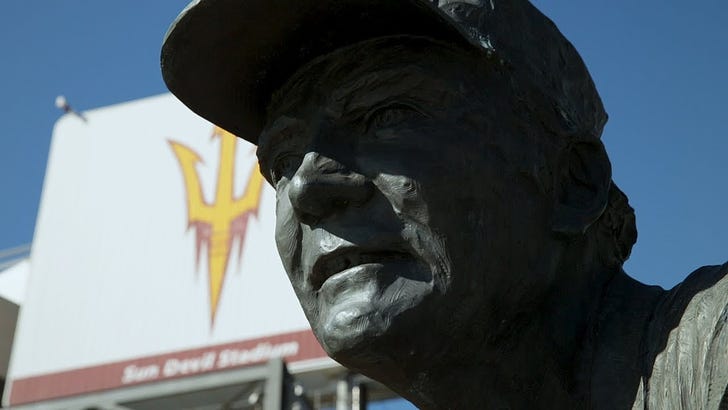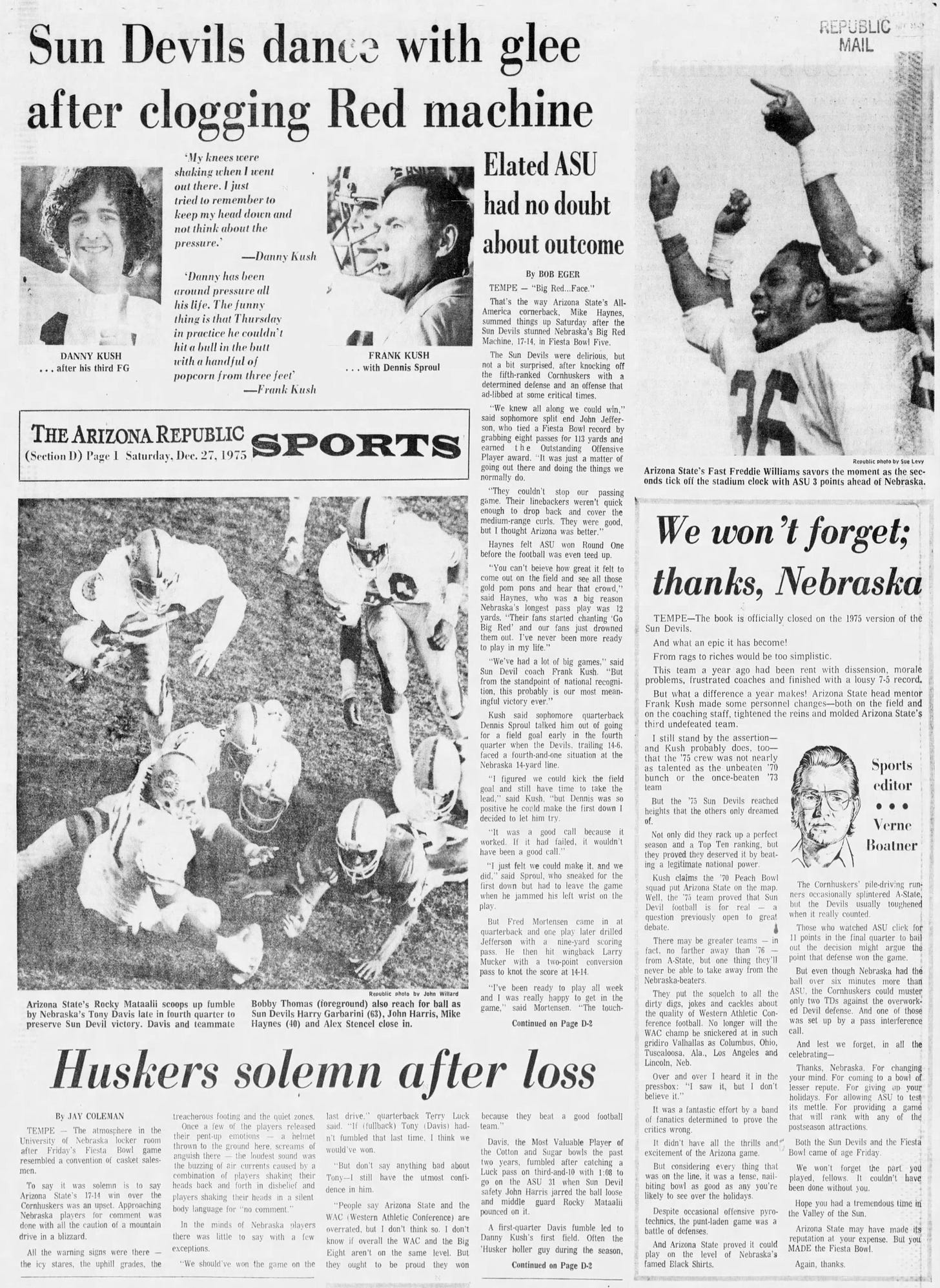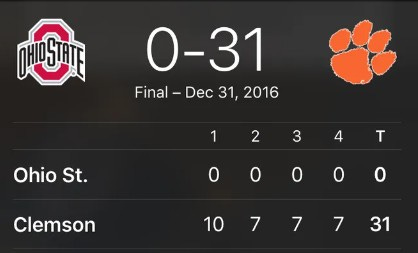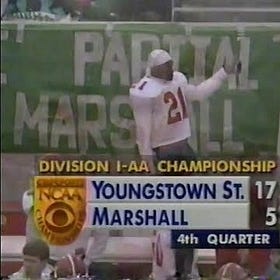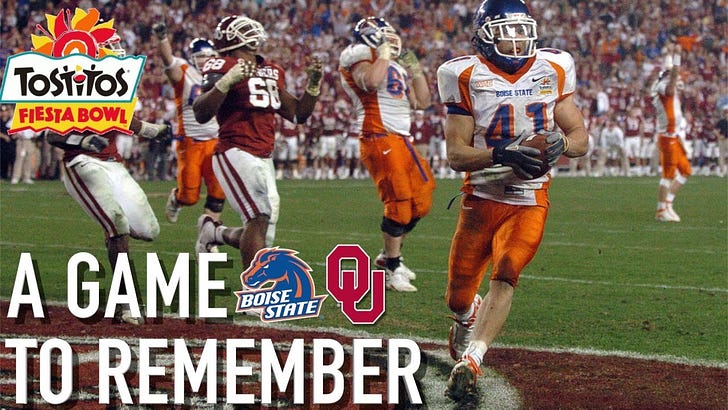Top 10 Tuesday: The Best Fiesta Bowl Games Ever Played
Since its debut in 1971, the Fiesta Bowl has played host to some of college football's most memorable and most important postseason games. Here are the top 10.
In Chapter 2 of the second installment of The Press Break Dead Conferences series, I took a dive into Frank Kush’s success at Arizona State and its role in forming the Fiesta Bowl. Almost immediately after its debut in 1971, the Phoenix-area postseason showcase evolved into one of the most prominent of college football’s bowls.
Dead Conferences Part 2, Chapter 2: Frank Kush and Arizona State Start A College Football Fiesta
Five years before the formation of the Western Athletic Conference, Arizona State completed its best season in the program’s history to that point with a 47-7 decimation of rival Arizona. The blowout capped a perfect, 10-0 season for the Sun Devils in which they dominated all comers by an average of 33.1 points per game.
The first installment of Top 10 Tuesday pays homage to Frank Kush’s lasting legacy with the 10 best1 editions of the Fiesta Bowl ever played.
December 2022: TCU 51, Michigan 45 (College Football Playoff)
Sloppy play and a variety of pivotal errors defined this recent installment in the Valley of the Sun’s marquee game. But damn if it wasn’t entertaining.I don’t doubt others would rank this one higher, given both the back-and-forth nature and the stakes as a College Football Playoff semifinal, and I can’t begrudge that. It’s the highest combined score in Fiesta Bowl history, highlighted by Max Duggan’s four touchdowns (two passing and two rushing).
The Dec. 2022 Fiesta Bowl is also memorable for the Andy Sidaris-inspired camerawork that fixated on J.J. McCarthy’s cheering section, specifically girlfriend Katya Kuropas. It’s for the best Brent Musburger was retired; I imagine his commentary would have caused a firestorm.
January 1999: Tennessee 23, Florida State 16 (BCS Championship Game)
The Bowl Championship Series launched in 1998 with the stated goal of satisfying those who wanted to crown a real national champion while preserving the tradition of college football’s bowl season. The compromise largely made neither side happy.College Football Championships with A Plus-One: The 1998 Season
·Among my earliest memories of college football is in 1991 when undefeated juggernauts in Miami and Washington split the national championship. Years later, this shared title became the quintessential example cited for the sport’s need to evolve its postseason and crown a “real” champion.
Despite evident flaws — including the exclusion of undefeated Tulane from an at-large berth in one of the four BCS bowls — backlash needed a few seasons to really build against the system. Football leadership was spared the headache of a title-game logjam when Texas A&M upset Kansas State in the Big 12 Championship Game. The same day, a September non-conference matchup between UCLA and Miami initially cancelled due to inclement weather resulted in the Bruins taking their first loss of the season.
Since one-loss Florida State beat the same two opponents that knocked off previously unbeaten K-State and UCLA, the BCS committee was gifted a stress-free Championship Game. Coupled with an outstanding game itself, the BCS was spared major criticism for a little while.
The Fiesta Bowl is noteworthy for Peyton Manning successor Tee Martin eclipsing his predecessor, at least for one night, and Peerless Price turning in one of the best individual performances in 20th Century bowl-game history. His 199 yards receiving, including the decisive 79-yarder in the fourth quarter, made Price a postseason legend.
December 1975: Arizona State 17, Nebraska 14
As noted in the above-linked Dead Conferences chapter on Frank Kush and Arizona State’s time in the Western Athletic Conference, ASU was instrumental in forming the Fiesta Bowl in 1971. Likewise, the Sun Devils were key to giving the game credibility as a top-tier event, courtesy of their 1975 top-10 clash with Nebraska.
Dead Conferences gets into the game with some depth, but as a teaser for those who have not read it, the 1975 Fiesta Bowl includes a declined invitation, a corrupt politician and his mailing of dozens of dead chickens to the University of Nebraska athletic department. Oh, and the game itself was pretty excellent.
January 1988: Florida State 31, Nebraska 28
Proponents of aggressive fourth-down play-calling will appreciate the 1988 Fiesta Bowl. In the game’s second of three straight top-5 matchups, No. 3 Florida State trailed fifth-ranked Nebraska late in the fourth quarter.
The Seminoles offense had stalled after scoring 21 second-quarter points against Nebraska’s Blackshirt defense, so Bobby Bowden had to have some reservations about Florida State’s prospects of converting a fourth-and-goal from the 15-yard line. Any reservations Bowden might have had were assuaged when Danny McManus found Ronald Lewis in the end zone and zipped a perfect pass through the window to score what proved to be the game-winning touchdown.The Cornhuskers moved inside on the ensuing possession — or at least, appeared to when Morgan Gregory took a reception to the two-yard line. Nebraska lining up illegally negated the big play and the Seminoles defense bowed up for the final two minutes.
January 1985: UCLA 39, Miami 37
UCLA fans might understandably cringe seeing the Bruins included in the same sentence as the words “Fiesta Bowl” and “Miami.” As noted in No. 9, a December loss to the Hurricanes prevented the 1998 Bruins from playing Tennessee for the first-ever BCS championship.
If it’s any consolation, UCLA scored one of its most impressive bowl-game wins in program history 14 years earlier against Miami.
The Bruins and Hurricanes traded the lead six times over a contest that featured four touchdowns of 33-plus yards: UCLA quarterback Steve Bono’s 33-yard pass to Mike Young; a 34-yard rush by Miami’s Darryl Oliver; a 48-yard Brian Blades reception from Bernie Kosar; and Eddie Brown’s 68-yard punt return touchdown.
UCLA gave up 13 unanswered points in the fourth quarter to cough up a two-score lead, but a chip-shot field goal and Terry Tumey’s sack of Kosar scored the Bruins their first (and only — they’ve never been back) Fiesta Bowl win.
January 1986: Michigan 27, Nebraska 23
When present-day Big Ten Conference counterparts met at the 1986 Fiesta Bowl, it was a reunion almost a quarter-century in the making. Michigan and Nebraska last faced in 1962 when the Cornhuskers scored a 25-13 win at the Big House. That came one season before Bo Schembechler took over as head coach at Miami Ohio, a move that eventually led him to Michigan.
Schembechler came to Michigan in 1969 and enjoyed a decade-long run of top-10 finished. As the ‘70s gave way to the ‘80s, the Wolverines’ magic faded somewhat: They lost three or four games five times from 1979 through 1984. But 1985 marked a return to form, with Michigan going 9-1-1 on its way to the Fiesta Bowl.
Under Tom Osborne, Nebraska routinely won 10-plus beginning in 1979 and the Huskers were out for a fourth straight (and what would have been an incredible eight consecutive) season of 10-plus wins when they faced Michigan in Tempe. Nebraska appeared headed that way in a dominant first half, too, before Jim Harbaugh took over in one of the most remarkable 15-minute stretches of Michigan football history.
December 2019: Clemson 29, Ohio State 23 (College Football Playoff)
The four-team College Football Playoff produced more duds in the semifinals than memorable matchups, which makes the Fiesta Bowl hosting two of the tournament’s best games especially remarkable. The Fiesta Bowl also hosted maybe the worst semifinal of the four-team Playoff era, coincidentally featuring the same two programs, so consider the 2019 season’s rematch karma paying the bowl back.
Ohio State and Clemson faced again and delivered an instant classic, highlighted by the definitive performance of Trevor Lawrence’s illustrious college career.
Lawrence ran for 107 yards, 67 of which came on a pivotal touchdown just before halftime. His carry, coupled with Travis Etienne’s touchdown run less than two minutes earlier, turned a potential three-score deficit at intermission into a near-tie.
Lawrence and Etienne again delivered heroics when they hooked up for the second of two touchdown connections with what was the game-winner — but not before one of the most thrilling final drives in bowl history. Nearly 17 years after a defensive play in the end zone fueled an Ohio State Fiesta Bowl win, another denied the Buckeyes.
January 2003: Ohio State 31, Miami 24 (BCS Championship Game)
Mention the BCS Championship Game’s return to Tempe, and the first item that comes to mind is Pass Interference. Now, if you’re familiar with the play then you already know why I write it as a proper noun.
For the uninitiated, check out the below breakdown on the fourth-down play that extended the 2003 Fiesta Bowl and ultimately denied Miami back-to-back national championships.
Considering the critical juncture of the game at which this penalty was called, it somewhat overshadows what was an otherwise remarkable contest. Miami came into the BCS Championship Game on a winner of 34 straight games, its last loss in September 2000.
The Hurricanes dominated almost all comers in 2001 — a late-season showdown with Virginia Tech the lone exception — behind a roster that could be argued is the most talented in college football history. The 2002 Hurricanes were not quite as loaded as the 2001 version, but mostly cruised through 12 regular-season wins. In contrast, fellow undefeated Ohio State beat plenty of quality opponents on its way to Tempe, including Pac-10 champion Washington State.
However, the Buckeyes’ win-ugly means of staying perfect, eeking out victories four times in which they failed to reach 20 points by the end of regulation, made them heavy underdogs against The U. Miami was favored by 11.5 points and thus shouldn’t have even come down to an overtime flag.
More than anything, though, this game stands out as the masterclass of Jim Tressel’s illustrious career. The Sweater Vest was not far removed from coaching Youngstown State to Div. I-AA glory, and this Buckeye team proved his vision could succeed at the highest levels of the college game.
The Championship Rivalry That Helped Shape 21st Century College Football
Four teams remain in the FCS Playoffs with the semifinals this weekend, and for the first time in more than a decade, not one is North Dakota State.
January 2007: Boise State 43, Oklahoma 42
A case can be made that this is the best Fiesta Bowl ever played, and is in the running for the most excited game of all-time — certainly in the 21st Century. Boise State was just the second-ever non-automatic qualifying conference program invited to the BCS, and the Broncos represented the Fiesta Bowl’s history as a stage for the Western Athletic Conference’s best against a nationally prominent opponent.
In his first season as head coach, Chris Petersen set the bar for all Boise State teams that followed — and perhaps did more to build the case for a playoff model akin to the 12-team format rolling out this season than anything before or since.College Football's Crossroads Intersect at Boise State
·LOS ANGELES — No program through the first two decades of the 21st Century more consistently ran up against but also chipped away at college football’s glass ceiling than Boise State. With the sport amid a period of more major changes in a shorter span than any time since in modern history, the Boise States of the world perhaps face an even stronger barrier between them and the game’s upper echelon.
Countless words have been dedicated to the 2007 Fiesta Bowl, so I won’t belabor the specifics. Just watch the highlights yourself and appreciate that this may be the closest big-time college football has come to producing a March Madness opening-weekend style upset.
January 1987: Penn State 14, Miami 10 (National Championship Game)
The first National Championship Game ever played at the Fiesta Bowl marked the culmination of a decade-long quest for the game’s organizers. Upon the end of its contract with the WAC, the Fiesta Bowl was unambigious in its ambitions to bring the national championship to Arizona.
It happened at the end of the 1986 season when the Fiesta Bowl’s organizers jumped to offer undefeated teams Penn State and Miami invitations before the conclusion of the regular season. The Nittany lions’ resume included a blowout of Alabama in Tuscaloosa and narrow wins over Maryland Notre Dame before a regular-season ending rout of Pitt.
Miami went largely uncontested in the regular season, a 23-15 win over Florida the Hurricanes’ only outcome decided by a single-digit margin. That includes a 28-16 win over No. 1-ranked Oklahoma in October.
This was Miami at the peak of its 1980s power, coached by the charismatic Jimmy Johnson and fully leaning into the image that came to define the program. A Palm Beach Post spread previewing the 1987 Fiesta Bowl contrasted Miami’s “breed apart” identity and called the Hurricanes, quite literally, “The Bad Guys.” The same preview presented Penn State as “The Good Guys,” “the squeaky clean ones.”
Now, history has shown this to be far more complex than presented, if not an outright fallacy. But the touchdown-favorite Hurricanes showing up to Arizona in army fatigues played into the build-up, which in turn played into the hard-hitting battle decided on a fourth-down red-zone play.
Results are completely subjective based on the author’s own opinion. Leave a comment if you feel there is a glaring omission!




